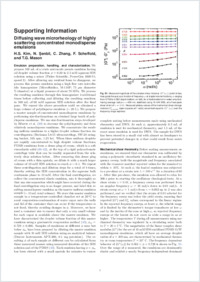Diffusing wave microrheology of highly scattering concentrated monodisperse emulsions
- Kim, Ha Seong Department of Chemistry and Biochemistry, University of California, Los Angeles, USA
- Şenbil, Nesrin Department of Physics, University of Fribourg, Switzerland
- Zhang, Chi Department of Physics, University of Fribourg, Switzerland
- Scheffold, Frank Department of Physics, University of Fribourg, Switzerland
- Mason, Thomas G. Department of Chemistry and Biochemistry, University of California, Los Angeles, USA - Department of Physics and Astronomy, University of California, Los Angeles, USA
-
16.04.2019
Published in:
- Proceedings of the National Academy of Sciences. - 2019, vol. 116, no. 16, p. 7766–7771
English
Motivated by improvements in diffusing wave spectroscopy (DWS) for nonergodic, highly optically scattering soft matter and by cursory treatment of collective scattering effects in prior DWS microrheology experiments, we investigate the low-frequency plateau elastic shear moduli G′p of concentrated, monodisperse, disordered oil-in- water emulsions as droplets jam. In such experiments, the droplets play dual roles both as optical probes and as the jammed objects that impart shear elasticity. Here, we demonstrate that collective scattering significantly affects DWS mean-square displacements (MSDs) in dense colloidal emulsions. By measuring and analyzing the scattering mean free path as a function of droplet volume fraction φ, we obtain a φ- dependent average structure factor. We use this to correct DWS MSDs by up to a factor of 4 and then calculate G′p predicted by the generalized Stokes–Einstein relation. We show that DWS-microrheological G′p(φ) agrees well with mechanically measured G′p(φ) over about three orders of magnitude when droplets are jammed but only weakly deformed. Moreover, both of these measurements are consistent with predictions of an entropic–electrostatic–interfacial (EEI) model, based on quasi- equilibrium free-energy minimization of disordered, screened-charge–stabilized, deformable droplets, which accurately describes prior mechanical measurements of G′p(φ) made on similar disordered monodisperse emulsions over a wide range of droplet radii and φ. This very good quantitative agreement between DWS microrheology, mechanical rheometry, and the EEI model provides a comprehensive and self-consistent view of weakly jammed emulsions. Extensions of this approach may improve DWS microrheology on other systems of dense, jammed colloids that are highly scattering.
- Faculty
- Faculté des sciences et de médecine
- Department
- Département de Physique
- Language
-
- English
- Classification
- Physics
- License
- License undefined
- Identifiers
-
- RERO DOC 324713
- DOI 10.1073/pnas.1817029116
- Persistent URL
- https://folia.unifr.ch/unifr/documents/307832
Other files
Statistics
Document views: 95
File downloads:
- sch_dwm.pdf: 88
- sch_dwm_sm.pdf: 105

